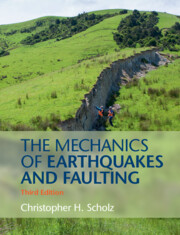Book contents
- The Mechanics of Earthquakes and Faulting
- Frontispiece
- The Mechanics of Earthquakes and Faulting
- Copyright page
- Epigraph
- Reviews
- Contents
- Preface to the first edition
- Preface to the second edition
- Preface to the third edition
- Symbols
- Chapter One Brittle fracture of rock
- Chapter Two Rock friction
- Chapter Three Mechanics of faulting
- Chapter Four Mechanics of earthquakes
- Chapter Five The seismic cycle
- Chapter Six Seismotectonics
- Chapter Seven Earthquake prediction and hazard analysis
- References
- Index
- Plate Section (PDF Only)
Chapter Two - Rock friction
Published online by Cambridge University Press: 17 December 2018
- The Mechanics of Earthquakes and Faulting
- Frontispiece
- The Mechanics of Earthquakes and Faulting
- Copyright page
- Epigraph
- Reviews
- Contents
- Preface to the first edition
- Preface to the second edition
- Preface to the third edition
- Symbols
- Chapter One Brittle fracture of rock
- Chapter Two Rock friction
- Chapter Three Mechanics of faulting
- Chapter Four Mechanics of earthquakes
- Chapter Five The seismic cycle
- Chapter Six Seismotectonics
- Chapter Seven Earthquake prediction and hazard analysis
- References
- Index
- Plate Section (PDF Only)
Summary
Once a fault has been formed its further motion is controlled by friction, which is a contact property rather than a bulk property. In the schizosphere the micromechanics of friction involve brittle fracture, but frictional behavior is fundamentally different from bulk brittle fracture. Here we examine this property in some detail and, in particular, discuss the stability of friction, which determines if fault motion is seismic or aseismic.
- Type
- Chapter
- Information
- The Mechanics of Earthquakes and Faulting , pp. 43 - 96Publisher: Cambridge University PressPrint publication year: 2019
- 4
- Cited by

